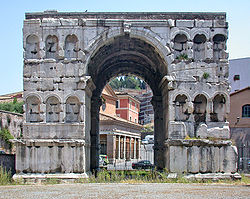
Arch of Janus
Encyclopedia

The Arch of Janus is the only quadrifrons
Quadrifrons
Quadrifrons is a Latin word, meaning four-fronted or four-faced, particularly:*Form of triumphal arch with four arches and hence with barrel vaulted passageway in the form of a cross.*Aspect of Janus, god.Quadrifrons is believed to be the fourth face of...
triumphal arch
Triumphal arch
A triumphal arch is a monumental structure in the shape of an archway with one or more arched passageways, often designed to span a road. In its simplest form a triumphal arch consists of two massive piers connected by an arch, crowned with a flat entablature or attic on which a statue might be...
preserved in Rome
Rome
Rome is the capital of Italy and the country's largest and most populated city and comune, with over 2.7 million residents in . The city is located in the central-western portion of the Italian Peninsula, on the Tiber River within the Lazio region of Italy.Rome's history spans two and a half...
, across a crossroads in the Velabrum
Velabrum
The Velabrum is the low valley in the city of Rome that connects the Forum with the Forum Boarium, and the Capitoline Hill with the western slope of the Palatine Hill. Before the construction of the Cloaca Maxima, which probably follows the course of an ancient stream, the area was a swamp...
-Forum Boarium
Forum Boarium
The Forum Boarium was the cattle forum venalium of Ancient Rome and the oldest forum that Rome possessed. It was located on a level piece of land near the Tiber between the Capitoline, the Palatine and Aventine hills. Here, too, is where the first bridges were built...
. It was built in the early 4th century of spolia
Spolia
Spolia is a modern art-historical term used to describe the re-use of earlier building material or decorative sculpture on new monuments...
, possibly in honour of Constantine I
Constantine I
Constantine the Great , also known as Constantine I or Saint Constantine, was Roman Emperor from 306 to 337. Well known for being the first Roman emperor to convert to Christianity, Constantine and co-Emperor Licinius issued the Edict of Milan in 313, which proclaimed religious tolerance of all...
or Constantius II
Constantius II
Constantius II , was Roman Emperor from 337 to 361. The second son of Constantine I and Fausta, he ascended to the throne with his brothers Constantine II and Constans upon their father's death....
. Its current name is probably from the Renaissance
Renaissance
The Renaissance was a cultural movement that spanned roughly the 14th to the 17th century, beginning in Italy in the Late Middle Ages and later spreading to the rest of Europe. The term is also used more loosely to refer to the historical era, but since the changes of the Renaissance were not...
or later and is not ancient. The name is derived from its four-fronted, four-arched structure.
In the Middle Ages
Middle Ages
The Middle Ages is a periodization of European history from the 5th century to the 15th century. The Middle Ages follows the fall of the Western Roman Empire in 476 and precedes the Early Modern Era. It is the middle period of a three-period division of Western history: Classic, Medieval and Modern...
, the Frangipane family transformed the building into a fortress and so it survived intact up until 1830. Then the attic
Attic
An attic is a space found directly below the pitched roof of a house or other building . Attic is generally the American/Canadian reference to it...
and top were torn down because they were erroneously believed not to belong to the original structure. Fragments of the dedicatory inscription are still preserved inside the nearby church of San Giorgio al Velabro
San Giorgio al Velabro
San Giorgio in Velabro is a minor basilica church in Rome, Italy, devoted to St. George.The church is located in the ancient Roman Velabrum, near the Arch of Janus, in the rione of Ripa. Sited near the River Tiber, it is within a complex of Republican-era pagan temples associated with the port of...
.

